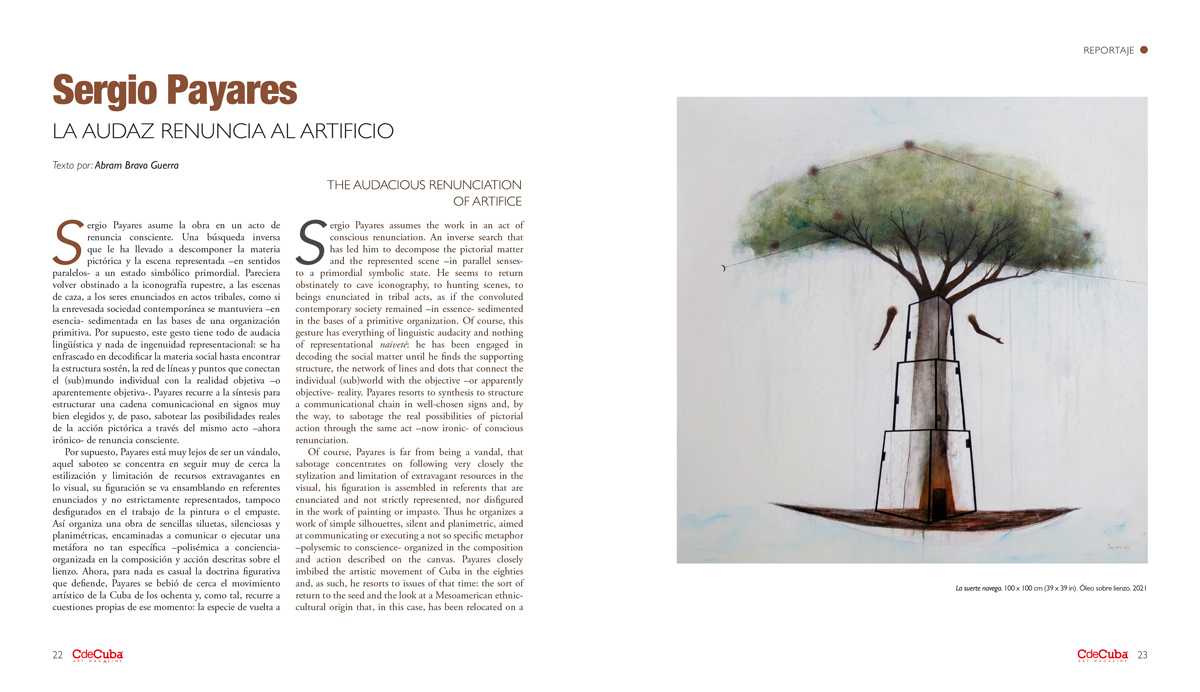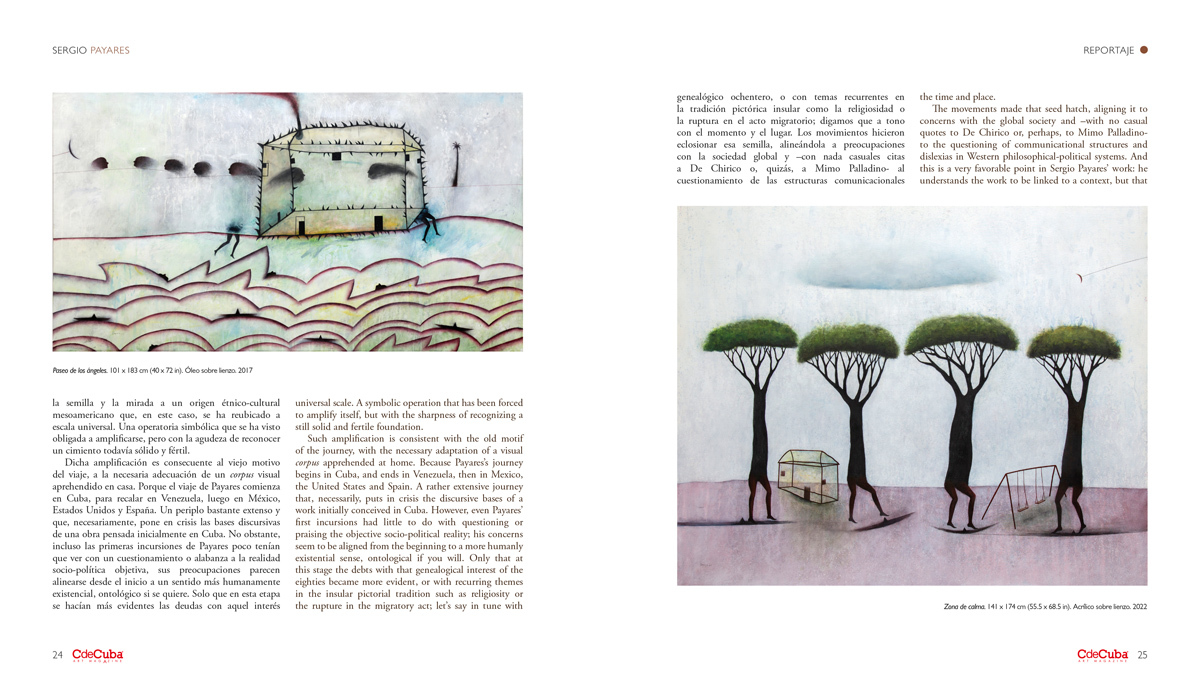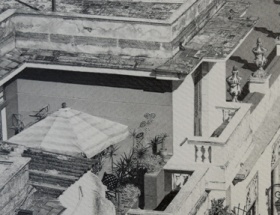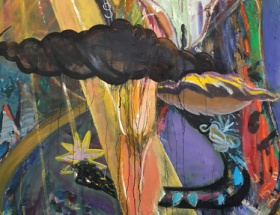The Audacious Renunciation of Artifice
By Abram Bravo Guerra
Sergio Payares assumes the work in an act of conscious renunciation. An inverse search that has led him to decompose the pictorial matter and the represented scene –in parallel senses- to a primordial symbolic state. He seems to return obstinately to cave iconography, to hunting scenes, to beings enunciated in tribal acts, as if the convoluted contemporary society remained –in essence- sedimented in the bases of a primitive organization. Of course, this gesture has everything of linguistic audacity and nothing of representational naiveté: he has been engaged in decoding the social matter until he finds the supporting structure, the network of lines and dots that connect the individual (sub)world with the objective –or apparently objective- reality. Payares resorts to synthesis to structure a communicational chain in well-chosen signs and, by the way, to sabotage the real possibilities of pictorial action through the same act –now ironic- of conscious renunciation.
Of course, Payares is far from being a vandal, that sabotage concentrates on following very closely the stylization and limitation of extravagant resources in the visual, his figuration is assembled in referents that are enunciated and not strictly represented, nor disfigured in the work of painting or impasto. Thus he organizes a work of simple silhouettes, silent and planimetric, aimed at communicating or executing a not so specific metaphor –polysemic to conscience- organized in the composition and action described on the canvas. Payares closely imbibed the artistic movement of Cuba in the eighties and, as such, he resorts to issues of that time: the sort of return to the seed and the look at a Mesoamerican ethnic-cultural origin that, in this case, has been relocated on a universal scale. A symbolic operation that has been forced to amplify itself, but with the sharpness of recognizing a still solid and fertile foundation.
Such amplification is consistent with the old motif of the journey, with the necessary adaptation of a visual corpus apprehended at home. Because Payares’s journey begins in Cuba, and ends in Venezuela, then in Mexico, the United States and Spain. A rather extensive journey that, necessarily, puts in crisis the discursive bases of a work initially conceived in Cuba. However, even Payares’ first incursions had little to do with questioning or praising the objective socio-political reality; his concerns seem to be aligned from the beginning to a more humanly existential sense, ontological if you will. Only that at this stage the debts with that genealogical interest of the eighties became more evident, or with recurring themes in the insular pictorial tradition such as religiosity or the rupture in the migratory act; let’s say in tune with the time and place.
The movements made that seed hatch, aligning it to concerns with the global society and –with no casual quotes to De Chirico or, perhaps, to Mimo Palladino- to the questioning of communicational structures and dislexias in Western philosophical-political systems. And this is a very favorable point in Sergio Payares’ work: he understands the work to be linked to a context, but that context is not a straitjacket, but rather the basic platform to develop a work designed for its horizontal functionality, in all possible markets and spaces. The interesting thing about Payares’ transit is precisely the renunciation of vertical discourse and the truthful demonstration of the adaptability of a fundamentally Cuban art.
Now –being more pragmatic in the analysis- I understand Payares’ figuration close to a spectrum of the surreal and the imaginary, that in a fully visual state. His canvases, cardboards or cartons, recreated in glazes and these split and drawn under the pressure of the burin, stamp archaic hyper-technologized societies in a kind of retro-futurism. Fragmented societies firstly in their material state –composed of severed, faceless, angular beings, truncated buildings, split in half or on one side, trees that listen and walk- and also in urban order –no streets, no doors, no cracks, leading to any objective place-. But, if for surrealism “meaninglessness” was a practical tool in its (non)meaning, for Payares it would be the shortest way to generate the explicit meaning that surrounds each painting. Payares is a painter of visual metaphors, of narratives; his micro-societies reveal his true intentions in astute twists of script. That is why primitive silences are broken into telecommunications towers, or Cuba splits a talking woman in half, or messages are interwoven in broken lines, or ancient plant beings wander aimlessly: each of Payares’ works is a closed fragment of history, a personal chapter returned to reflect in multitudinous language. He disembodies the disconnected nerves of today’s society, now assembled in its silent and incoherent tribes, painted in the signs and arrows of his postmodern Lascaux cave: as if the image, deceptive, still needed the same directionality and certainty of the written word.
Broadly speaking, Sergio Payares’ resignation ends in terms of equitable exchange: like the old alchemists, he gives and gets in equal measure. Then his dialogue takes the form of a work, and reverts to the communicative capacity it acquires in any context. It is very interesting that he efficiently externalizes the same phenomenon that, more than once, torments him in his pieces: he communicates to the same extent that he is obsessed with communication, with the social being. He has found the right formula for the specific urgency. And, in the end, he becomes a peculiar analyst of the human being, of an ancestral state that has slipped –with a certain mischievousness- into today’s hypertrophied society.






